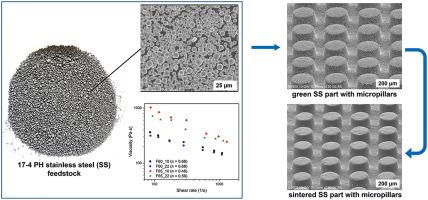Precision Engineering ( IF 3.5 ) Pub Date : 2021-07-06 , DOI: 10.1016/j.precisioneng.2021.06.014 Lena Ammosova 1 , Santiago Cano Cano 2 , Stephan Schuschnigg 2 , Christian Kukla 3 , Kari Mönkkönen 4 , Mika Suvanto 1 , Joamin Gonzalez-Gutierrez 2

|
Metal injection moulding of miniaturized devices demands unique feedstock materials and mould designs with high dimensional accuracy. In this work, the influences of the powder size and powder content of 17–4 PH stainless steel feedstock and the influence of mould design on the successful production of micro-scaled structures were investigated. Ni mould inserts with high dimensional accuracy and texture sizes of 50–200 μm using a new microtexturing technique were manufactured. 17–4 PH stainless steel feedstocks with powder sizes (D90) of 10 and 22 μm and powder contents of 60 and 65 vol.-% were compounded. The rheological properties of the obtained feedstocks were characterized with a capillary rheometer to assess their flowability. The results showed that 10 μm sized particles caused a slight but not significant increase in the viscosity. The highest viscosity increase occurred when the powder content increased from 60 to 65 vol.-%. Feedstocks with the 10 μm powder particles ensured complete filling within microtextures for all mould variations. However, when using feedstocks with 22 μm particles, the filling capabilities of the 50 and 100 μm microtextures decreased with increasing powder content. The shape retention was better for those micropillars produced with mould inserts with 200 μm cavities than for the micropillars replicated with the inserts having cavities of 50 and 100 μm. The results indicated that the proposed mould insert preparation technique opens new possibilities for mass production using the μMIM process to create micro-scaled components using feedstocks without nanoparticles.
中文翻译:

金属粒径和粉末体积分数对微纹理表面粉末注射成型零件填充性能的影响
微型设备的金属注射成型需要具有高尺寸精度的独特原料材料和模具设计。在这项工作中,研究了 17-4 PH 不锈钢原料的粉末尺寸和粉末含量的影响以及模具设计对成功生产微尺度结构的影响。使用新的显微纹理技术制造了具有高尺寸精度和 50-200 μm 纹理尺寸的镍模具嵌件。具有粉末尺寸的 17–4 PH 不锈钢原料 (D 90) 的 10 和 22 μm 以及 60 和 65 vol.-% 的粉末含量。所得原料的流变特性用毛细管流变仪表征以评估它们的流动性。结果表明,10 μm 大小的颗粒引起粘度的轻微但不显着增加。当粉末含量从 60 vol.-% 增加到 65 vol.-% 时,粘度增加最高。具有 10 μm 粉末颗粒的原料确保在所有模具变体的微观纹理内完全填充。然而,当使用 22 μm 颗粒的原料时,50 和 100 μm 微纹理的填充能力随着粉末含量的增加而降低。与使用具有 50 和 100 μm 腔的插入件复制的微柱相比,使用具有 200 μm 腔的模具插入件生产的那些微柱的形状保持性更好。结果表明,所提出的模具嵌件制备技术为使用 μMIM 工艺的大规模生产开辟了新的可能性,以使用不含纳米颗粒的原料制造微型组件。











































 京公网安备 11010802027423号
京公网安备 11010802027423号